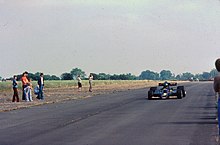
Anthony Colin Bruce Chapman was an English design engineer, inventor, and builder in the automotive industry, and founder of the sports car company Lotus Cars.
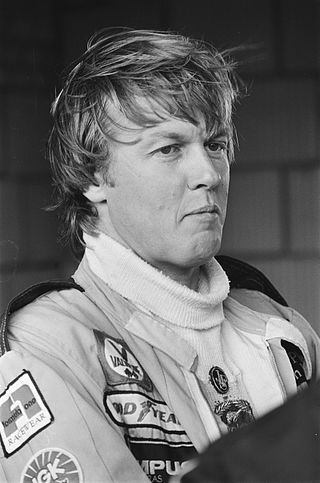
Bengt Ronnie Peterson was a Swedish racing driver, who competed in Formula One from 1970 to 1978. Nicknamed "Superswede", Peterson twice finished runner-up in the Formula One World Drivers' Championship in 1971 and 1978, and won 10 Grands Prix across nine seasons.

The 1978 Spanish Grand Prix was a Formula One motor race held on 4 June 1978 at Jarama. It was the seventh race of the 1978 World Championship of F1 Drivers and the 1978 International Cup for F1 Constructors. The 75-lap race was won from pole position by Mario Andretti, driving a Lotus-Ford, with teammate Ronnie Peterson second and Jacques Laffite third in a Ligier-Matra.

The 1978 Swedish Grand Prix was a Formula One motor race held on 17 June 1978 at the Scandinavian Raceway. It was the eighth race of the 1978 World Championship of F1 Drivers and the 1978 International Cup for F1 Constructors, and the last Formula One Swedish Grand Prix to date.
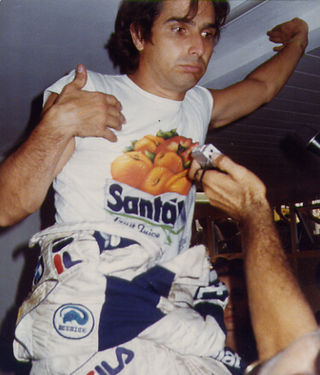
The 1981 FIA Formula One World Championship was the 35th season of FIA Formula One motor racing. It featured the 1981 Formula One World Championship for Drivers and the 1981 Formula One World Championship for Manufacturers, which were contested over a fifteen-race series that commenced on 15 March and ended on 17 October. The 1981 South African Grand Prix, as a non-championship race due to difficulties from the ongoing FISA–FOCA war, was open to Formula One entrants but was not part of the World Championship.
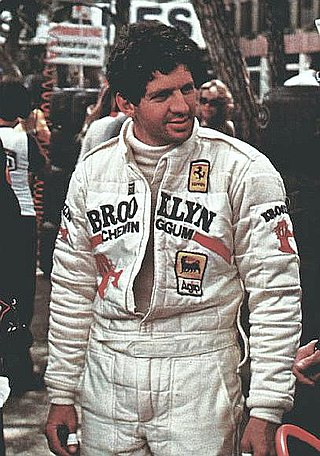
The 1979 Formula One season was the 33rd season of FIA Formula One motor racing. It featured the 1979 World Championship of F1 Drivers and the 1979 International Cup for F1 Constructors which were contested concurrently over a fifteen-round series which commenced on 21 January 1979, and ended on 7 October 1979. The season also included three non-championship Formula One races.
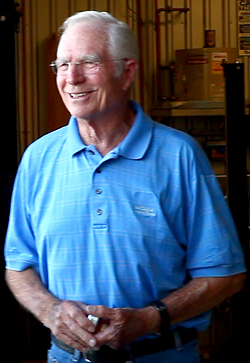
James Ellis Hall is a retired American racing driver, race car constructor, and team owner. While he is best known as a car constructor, he was one of the greatest American racing drivers of his generation, capturing consecutive United States Road Racing Championships, two Road America 500s, two Watkins Glen Grands Prix for sports cars, the 1965 Canadian Grand Prix for sports cars, the 1965 Pacific Northwest Grand Prix, and scoring a massive upset at the 1965 12 Hours of Sebring over a contingent of factory-backed Ford GTs, Shelby Daytona Coupes, and Ferrari entries. If anything Hall's accomplishments behind the wheel have been overshadowed by his pivotal contributions to race car design through his series of Chaparral sports racing and Indy cars. Hall's cars won in every series in which they competed: USRRC, Can-Am, Trans-Am, Formula 5000, World Sportscar Championship, Autoweek Championship, Canadian Sports Car Championship, and the Indianapolis 500.

The 1977 United States Grand Prix West was a Formula One motor race held on April 3, 1977 in Long Beach, California. It was the fourth race of the 1977 World Championship of F1 Drivers and the 1977 International Cup for F1 Constructors.
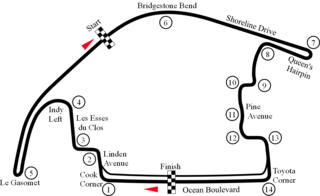
The 1981 United States Grand Prix West was a Formula One motor race held on March 15, 1981, at Long Beach, California. It was the opening race of the 1981 Formula One World Championship.

Team Lotus was the motorsport sister company of English sports car manufacturer Lotus Cars. The team ran cars in many motorsport categories including Formula One, Formula Two, Formula Ford, Formula Junior, IndyCar, and sports car racing. More than ten years after its last race, Team Lotus remained one of the most successful racing teams of all time, winning seven Formula One Constructors' titles, six Drivers' Championships, and the Indianapolis 500 in the United States between 1962 and 1978. Under the direction of founder and chief designer Colin Chapman, Lotus was responsible for many innovative and experimental developments in critical motorsport, in both technical and commercial arenas.

The Brabham BT46 is a Formula One racing car designed by Gordon Murray for the Brabham team, owned by Bernie Ecclestone, for the 1978 Formula One season. The car featured several radical design elements, one of which was the use of flat panel heat exchangers on the bodywork of the car to replace conventional water and oil radiators. It was removed before the car's race debut, never to be seen again. The cars, powered by a flat-12 Alfa Romeo engine, raced competitively with modified nose-mounted radiators for most of the year, driven by Niki Lauda and John Watson, winning one race in this form and scoring sufficient points for the team to finish third in the constructors' championship.

The Lotus 79 is a Formula One car designed in late 1977 by Colin Chapman, Geoff Aldridge, Martin Ogilvie, Tony Rudd, Tony Southgate and Peter Wright of Lotus. The Lotus 79 was the first F1 car to take full advantage of ground effect aerodynamics.
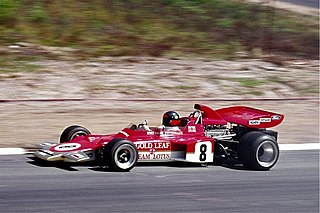
The Lotus 72 is a Formula One car designed by Colin Chapman and Maurice Philippe of Lotus for the 1970 Formula One season. The 72 was a pioneering design featuring inboard brakes, side-mounted radiators in sidepods, and aerodynamic wings producing down-force.

The Lotus 88 is an innovative Formula One car designed by Colin Chapman, Peter Wright, Tony Rudd and Martin Ogilvie of Lotus in an effort to maximise the downforce produced by ground effect. The Lotus 88 made its debut at the first practice session of the 1981 season opener, the US Grand Prix West at Long Beach. Although the Lotus 88 was not allowed to race, it was the first Formula One car to use a carbon fibre monocoque chassis and debut at a Grand Prix event. The carbon fibre McLaren MP4 made its first appearance at the third Grand Prix of the season in Argentina.

The Williams FW07 was a ground effect Formula One racing car designed by Patrick Head, Frank Dernie, and Neil Oatley for the 1979 F1 season.

The Brabham BT49 is a Formula One racing car designed by South African Gordon Murray for the British Brabham team. The BT49 competed in the 1979 to 1982 Formula One World Championships and was used by Brazilian driver Nelson Piquet to win his first World Championship in 1981.

The Lotus 80 was a Formula One car used by Team Lotus in 1979. The car, designed by Colin Chapman, Martin Ogilvie, Peter Wright and Tony Rudd, was an attempt to take ground effect as far as possible.
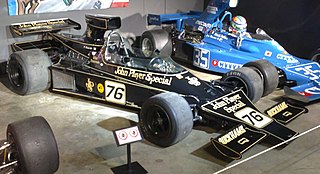
The Lotus 76 is a Formula One car designed by Colin Chapman, Tony Rudd and Ralph Bellamy and used by Team Lotus in the 1974 Formula One season.

The Lotus 77 was a Formula One racing car designed by Colin Chapman, Geoff Aldridge and Martin Ogilvie for the 1976 Formula One season.
In car design, ground effect is a series of effects which have been exploited in automotive aerodynamics to create downforce, particularly in racing cars. This has been the successor to the earlier dominant aerodynamic focus on streamlining. The international Formula One series and American racing IndyCars employ ground effects in their engineering and designs. Similarly, they are also employed in other racing series to some extent; however, across Europe, many series employ regulations to limit its effectiveness on safety grounds.

